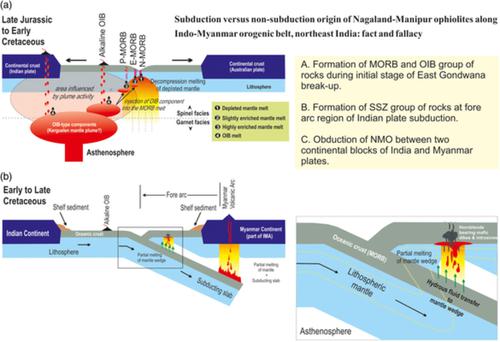当前位置:
X-MOL 学术
›
Geolog. J.
›
论文详情
Our official English website, www.x-mol.net, welcomes your
feedback! (Note: you will need to create a separate account there.)
Subduction versus non‐subduction origin of the Nagaland‐Manipur Ophiolites along the Indo‐Myanmar Orogenic Belt, northeast India: Fact and fallacy
Geological Journal ( IF 1.4 ) Pub Date : 2020-11-02 , DOI: 10.1002/gj.4030 Shoraisam Khogenkumar 1 , Athokpam Krishnakanta Singh 2 , Santosh Kumar 3 , Nongmaithem Lakhan 2 , Monika Chaubey 2 , Sashimeren Imtisunep 2 , Amrita Dutt 2 , Govind Oinam 2
Geological Journal ( IF 1.4 ) Pub Date : 2020-11-02 , DOI: 10.1002/gj.4030 Shoraisam Khogenkumar 1 , Athokpam Krishnakanta Singh 2 , Santosh Kumar 3 , Nongmaithem Lakhan 2 , Monika Chaubey 2 , Sashimeren Imtisunep 2 , Amrita Dutt 2 , Govind Oinam 2
Affiliation

|
The Nagaland‐Manipur Ophiolites (NMO) in northeast India is known for its complex geological history. Tough terrain, thick vegetation, and dismembered exposure of ophiolitic suite of rocks in the region made uneasy for geological investigation and put it in a deadlock for a long time. Only in the last decade has seen an appreciable amount of publications but the results boil down to a hot debate between two opposite schools of thoughts of subduction origin versus non‐subduction origin of the NMO. In this article, we revisit the literature data and compare it with our new geochemical data with an attempt to provide fresh insight into the long‐standing debate on the geodynamic evolution of the NMO. Our investigation arrives at the conclusion that the NMO as a whole cannot be considered as 100% subduction or 100% non‐subduction origin. It is indeed a combination of both. The non‐subduction group of mafic rocks shows a high ratio of incompatible elements (Nb/Yb >1), high‐Ti, enriched LILE, and HFSE with primitive mantle normalized values >5. Their bulk‐rock geochemical composition is equivalent to mid‐ocean ridge basalt (MORB) and ocean island basalt (OIB). The subduction group of rocks, on the other hand, shows a low ratio of incompatible elements (Nb/Yb <1), low‐Ti, depleted LILE, and HFSE with primitive mantle normalized values <1, affinity to the fore‐arc depleted N‐MORB type. Similarly, spinels present in subduction‐influenced mantle rocks show high chromium content (Cr# >50) but it is lower (Cr# <50) in non‐subduction abyssal peridotites of the NMO. Such geochemical variations cannot simply be explained by fractional crystallization or variable degree of partial melting of a single source, but rather signifies derivation from different tectonic settings of subduction and non‐subduction magma factories. We further conclude that the primary compressional force of India‐Myanmar Plate collision and secondary strike‐slip faults running along this ophiolite belt jeopardized the accretionary process which led to distortion and dismembering of the rocks like a scrambled bread.
中文翻译:

印度东北部印度-缅甸造山带上那加兰—马尼普尔蛇绿岩的俯冲与非俯冲成因:事实与谬误
印度东北部的那加兰邦-马尼普尔蛇绿岩(NMO)以其复杂的地质历史而闻名。崎ough的地形,茂密的植被以及该地区的脂滑石层的裸露使地质调查变得不安,并使其长期陷入僵局。仅在最近十年中,发表了相当数量的出版物,但结果归结为两种相反的NMO俯冲起源与非俯冲起源学派之间的激烈辩论。在本文中,我们将回顾文献数据,并将其与新的地球化学数据进行比较,以期为有关NMO地球动力学演变的长期辩论提供新的见解。我们的调查得出的结论是,整个NMO不能被视为100%俯冲或100%非俯冲的起源。这确实是两者的结合。基性岩的非俯冲组显示出不相容元素的比率高(Nb / Yb> 1),高Ti,富集的LILE和HFSE,原始地幔归一化值> 5。它们的大块岩石地球化学成分相当于中海脊玄武岩(MORB)和大洋洲玄武岩(OIB)。另一方面,俯冲岩石组的不相容元素(Nb / Yb <1),低Ti,贫化的LILE和HFSE的比例低,原始地幔归一化值<1,与前弧贫化的亲和力N‐MORB类型。同样,俯冲影响的地幔岩石中存在的尖晶石具有较高的铬含量(Cr#> 50),但在非俯冲的深海橄榄岩橄榄岩中的铬含量较低(Cr#<50)。这种地球化学变化不能简单地用部分源的分步结晶或部分融化的不同程度来解释,而是表示是从俯冲和非俯冲岩浆工厂的不同构造环境中衍生出来的。我们进一步得出结论,印度-缅甸板块碰撞的主要压缩力和沿蛇绿岩带的次生走滑断层破坏了增生过程,导致岩石变形和解体,如炒面包一样。
更新日期:2020-11-02
中文翻译:

印度东北部印度-缅甸造山带上那加兰—马尼普尔蛇绿岩的俯冲与非俯冲成因:事实与谬误
印度东北部的那加兰邦-马尼普尔蛇绿岩(NMO)以其复杂的地质历史而闻名。崎ough的地形,茂密的植被以及该地区的脂滑石层的裸露使地质调查变得不安,并使其长期陷入僵局。仅在最近十年中,发表了相当数量的出版物,但结果归结为两种相反的NMO俯冲起源与非俯冲起源学派之间的激烈辩论。在本文中,我们将回顾文献数据,并将其与新的地球化学数据进行比较,以期为有关NMO地球动力学演变的长期辩论提供新的见解。我们的调查得出的结论是,整个NMO不能被视为100%俯冲或100%非俯冲的起源。这确实是两者的结合。基性岩的非俯冲组显示出不相容元素的比率高(Nb / Yb> 1),高Ti,富集的LILE和HFSE,原始地幔归一化值> 5。它们的大块岩石地球化学成分相当于中海脊玄武岩(MORB)和大洋洲玄武岩(OIB)。另一方面,俯冲岩石组的不相容元素(Nb / Yb <1),低Ti,贫化的LILE和HFSE的比例低,原始地幔归一化值<1,与前弧贫化的亲和力N‐MORB类型。同样,俯冲影响的地幔岩石中存在的尖晶石具有较高的铬含量(Cr#> 50),但在非俯冲的深海橄榄岩橄榄岩中的铬含量较低(Cr#<50)。这种地球化学变化不能简单地用部分源的分步结晶或部分融化的不同程度来解释,而是表示是从俯冲和非俯冲岩浆工厂的不同构造环境中衍生出来的。我们进一步得出结论,印度-缅甸板块碰撞的主要压缩力和沿蛇绿岩带的次生走滑断层破坏了增生过程,导致岩石变形和解体,如炒面包一样。









































 京公网安备 11010802027423号
京公网安备 11010802027423号